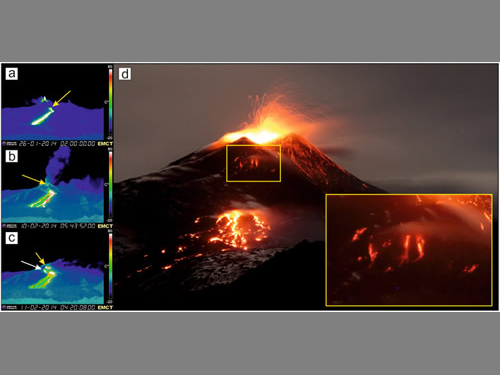Pyroclastic density currents at Etna volcano, Italy: The 11 February 2014 case study

Andronico D., A. Di Roberto, E. De Benia, B. Behncke, A. Bertagnini, P. Del Carlo, M. Pompilio (2018).
Journal of Volcanology and Geothermal Research, 357, 92–105, https://doi.org/10.1016/j.jvolgeores.2018.04.012
Abstract
On 11 February 2014, a considerable volume (0.82 to 1.29 × 106 m3) of unstable and hot rocks detached from the lower–eastern flank of the New Southeast Crater (NSEC) at Mt. Etna, producing a pyroclastic density current (PDC). This event was by far the most extensive ever recorded at Mt. Etna since 1999 and has attracted the attention of the scientific community and civil protection to this type of volcanic phenomena, usually occurring without any clear volcanological precursor and especially toward the mechanisms which led to the crater collapse, the PDC flow dynamics and the related volcanic hazard. We present here the results of the investigation carried out on the 11 February 2014 collapse and PDC events; data were obtained through a multidisciplinary approach which includes the analysis of photograph, images from visible and thermal surveillance cameras, and the detailed stratigraphic, textural and petrographic investigations of the PDC deposits. Results suggest that the collapse and consequent PDC was the result of a progressive thermal and mechanical weakening of the cone by repeated surges of magma passing through it during the eruptive activity prior to the 11 February 2014 events, as well as pervasive heating and corrosion by volcanic gas. The collapse of the lower portion of the NSEC was followed by the formation of a relatively hot (up to 750 °C) dense flow which travelled about 2.3 km from the source, stopping shortly after the break of the slope and emplacing the main body of the deposit which ranges between 0.39 and 0.92 × 106 m3. This flow was accompanied a relatively hot cloud of fine ash that dispersed over a wider area.
The results presented may contribute to the understanding of this very complex type of volcanic phenomena at Mt. Etna and in similar volcanic settings of the world. In addition, results will lay the basis for the modeling of crater collapse and relative PDC events and consequently for the planning of hazard assessment strategies aimed at reducing the potential risks to scientists and tens of thousands of tourists visiting Etna’s summit areas every year.


Devi effettuare l'accesso per postare un commento.